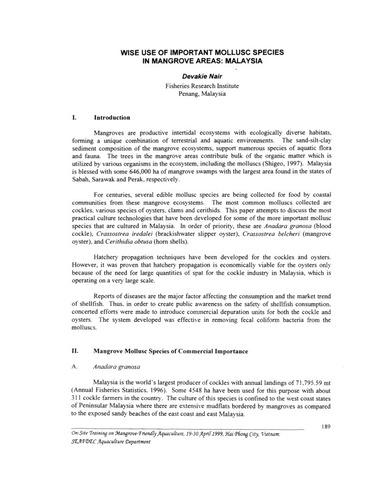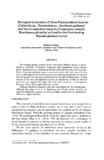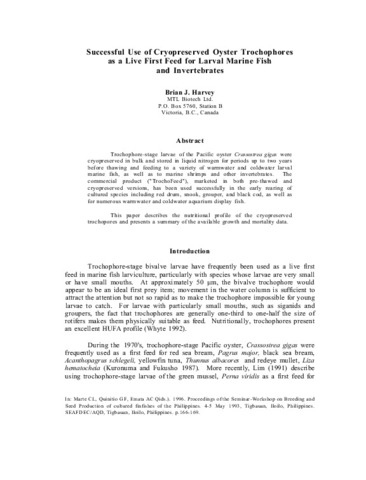Wise use of important mollusc species in mangrove areas: Malaysia
- Global styles
- MLA
- Vancouver
- Elsevier - Harvard
- APA
- Help

Date
2000Author
Page views
2,007ASFA keyword
AGROVOC keyword
Taxonomic term
Metadata
Show full item record
Share
Abstract
For centuries, several edible mollusc species are being collected for food by coastal communities from these mangrove ecosystems. The most common molluscs collected are cockles, various species of oysters, clams and cerithids. This paper attempts to discuss the most practical culture technologies that have been developed for some of the more important mollusc species that are cultured in Malaysia. In order of priority, these are Anadara granosa (blood cockle), Crassostrea iredalei (brackishwater slipper oyster), Crassostrea belcheri (mangrove oyster), and Cerithidia obtusa (horn shells).
Suggested Citation
Nair, D. (2000). Wise use of important mollusc species in mangrove areas: Malaysia. In Y. Tadokoro, V. T. Sulit, & R. B. Abastillas (Comps.), Technologies in Mangrove-Friendly Aquaculture. Final Report of and Papers Presented to the On-Site Training on Mangrove-Friendly Aquaculture, Hai Phong City, Socialist Republic of Vietnam, 19-30 April 1999 (pp. 189–198). Tigbauan, Iloilo, Philippines: Aquaculture Department, Southeast Asian Fisheries Development Center.
Type
Book chapterCollections
Related items
Showing items related by title, author, creator and subject.
-
Biological evaluation of three phytoplankton species (Chlorella sp., Tetraselmis sp., Isochrysis galbana) and two zooplankton species (Crassostrea iredalei, Brachionus plicatilis) as food for the first-feeding Siganus guttatus larvae
Duray, Marietta N. (University of San Carlos, 1986)First-feeding Siganus guttatus larvae were given different species of phytoplankton (Chlorella, Tetraselmis, Isochrysis) and zooplankton (oyster trochophores, Brachionus) or a combination of both on the first day when they ... -
A method of culturing/ growing high-quality edible oysters (Crassostrea spp. and Magallana bilineata)
Lebata-Ramos, Ma. Junemie Hazel; Southeast Asian Fisheries Development Center/Aquaculture Department (Intellectual Property Office of the Philippines, 2024-11-18)This utility model discloses a process of culturing/ growing high-quality edible oysters (Crassostrea spp. and Magallana bilineata) comprising the steps: selecting grow-out culture sites, deploying substrates ... -
Successful use of cryopreserved oyster trocophores as a live first feed larval marine fish and invertebrates
Harvey, Brian J. (Aquaculture Department, Southeast Asian Fisheries Development Center, 1996)Trochophore-stage larvae of the Pacific oyster Crassostrea gigas were cryopreserved in bulk and stored in liquid nitrogen for periods up to two years before thawing and feeding to a variety of warmwater and coldwater larval ...






